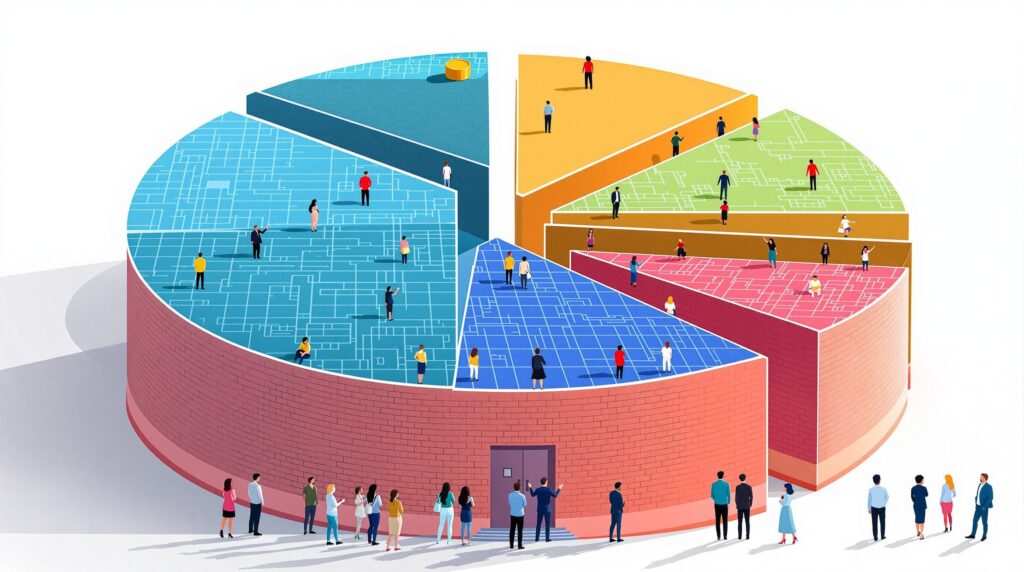[rev_slider alias=”slider-1″][/rev_slider]
Introduction to Layer 1 Blockchains
Understanding the role of Layer 1 blockchains in the cryptocurrency ecosystem is crucial. These foundational networks serve as the infrastructure for decentralized platforms and various digital currency operations. In this section, we will explore the fundamental characteristics of Layer 1 blockchains and their importance in the crypto world.
What is a Layer 1 blockchain? A Layer 1 blockchain is the base layer or main network in a blockchain architecture that processes transactions directly on its own chain without relying on other networks.
Layer 1 blockchains are like the foundations upon which skyscrapers are built. Just as a strong foundation supports the entire structure above, Layer 1 networks provide the basic framework that enables decentralized applications, smart contracts, and the secure exchange of digital assets.
Key Characteristics of Layer 1 Blockchains
- Decentralization: One of the primary goals of Layer 1 blockchains is to achieve decentralization, ensuring no single entity controls the network. This is crucial for maintaining the integrity and security of the blockchain.
- Scalability: Scalability refers to a blockchain’s ability to handle an increasing number of transactions. Layer 1 solutions focus on enhancing this capacity as transaction volumes grow.
- Security: Layer 1 blockchains prioritize security by utilizing robust consensus mechanisms like Proof of Work (PoW) and Proof of Stake (PoS) to secure the network against malicious attacks.
- Interoperability: The ability of a blockchain to interact with other blockchains and systems is critical. Layer 1 solutions aim to enhance interoperability to support a broader ecosystem.
Each of these characteristics plays a vital role in shaping the efficiency and reliability of blockchain technology. As blockchain popularity continues to rise in Africa, understanding these traits becomes increasingly important.
The Role of Ethereum, Solana, and Avalanche
As the demand for decentralized finance (DeFi) and digital transformation expands globally, several Layer 1 blockchains have emerged, each offering distinct advantages. Among them, Ethereum, Solana, and Avalanche stand out due to their unique contributions and capabilities:
- Ethereum: Known as the pioneer of smart contracts and decentralized applications (dApps), Ethereum laid the groundwork for blockchain-based solutions. Its robust ecosystem supports a wide range of applications, making it a leader in the DeFi space.
- Solana: Renowned for its speed and low transaction costs, Solana addresses scalability issues, making it ideal for high-volume applications. Its unique architecture enables it to process thousands of transactions per second.
- Avalanche: Combining high throughput with fast finality, Avalanche is designed to be highly adaptable, supporting a variety of custom blockchain needs. Its consensus protocol ensures low latency and efficient scaling.
By bridging global capital to African assets, platforms like Jara are poised to harness the potentials of these Layer 1 blockchains to fuel Africa’s digital asset economy.
This content is formatted in HTML, ready for integration into WordPress, and includes sections laid out for readability and optimized for SEO with strategic keyword placement and relevant internal [links](https://leppardlaw.com/criminal-law/fraud/defense-of-crimes-involving-bitcoin-and-cryptocurrency/). The explanation of Layer 1 blockchains is structured to engage and educate readers while maintaining a connection to Jara’s objectives.
Comparing Ethereum, Solana, and Avalanche: Key Features
Ethereum, Solana, and Avalanche each offer distinct features and advantages, making them leading contenders in the blockchain realm. But what sets these Layer 1 blockchains apart, and how do they fare against each other? Let’s dive into their key features to illuminate their unique offerings.
Ethereum: The Pioneer of Smart Contracts
Ethereum is heralded as the first blockchain platform to introduce and popularize smart contracts, which are self-executing contracts with the terms of the agreement directly written into code. But why is Ethereum so widely adopted in the blockchain world?
- Smart Contract Functionality: Ethereum’s capability to automate agreements without intermediaries enhances efficiency and reduces costs, making it a primary choice for decentralized applications (dApps).
- Decentralized Finance (DeFi) Ecosystem: Ethereum is the foundation for most DeFi applications, enabling users to lend, borrow, and earn interest with robust security.
- Network Security: Utilizing a proof-of-work (PoW) consensus mechanism, Ethereum boasts high security levels.
- Transition to Ethereum 2.0: With its upcoming move to a proof-of-stake (PoS) model, Ethereum aims to enhance scalability and reduce environmental impact.
Ethereum’s wide adoption is mainly due to its pioneering role in smart contracts and its expansive DeFi ecosystem, revolutionizing traditional finance significantly.
Solana: Speed and Cost-Effectiveness
Solana has gained immense popularity due to its high-speed transactions and low fees. But what makes Solana a standout choice among developers and businesses?
- High Throughput: Solana can process up to 65,000 transactions per second (tps), which makes it one of the fastest blockchains in operation.
- Low Transaction Fees: With fees averaging a fraction of a cent, Solana offers cost benefits unmatched by many competitors.
- Proof of History (PoH): This innovative technology enables Solana to timestamp and sequence transactions without sacrificing security, thus enhancing scalability without compromising performance.
- Vibrant Developer Community: Encouraging rapid innovation and deployment of dApps, Solana’s active community contributes to its dynamic ecosystem.
Solana’s remarkable speed and economical transaction fees make it an attractive platform for developers seeking efficient and cost-effective blockchain solutions.
Avalanche: Scalability and Interoperability
Avalanche is renowned for its exceptional scalability and interoperability features. How does it manage to stand out in the crowded blockchain space?
- Subnet Technology: Avalanche introduces subnets that empower custom blockchain creation, fostering tailored solutions for specific applications.
- High Security and Decentralization: Avalanche employs a unique consensus protocol offering fast finality and resistance to common security vulnerabilities.
- Interoperability: Its architecture allows seamless cross-chain interactions, broadening its use case potential.
- Low Latency and High Output: With transaction finality achieved within seconds, Avalanche optimizes efficiency without sacrificing output.
Avalanche’s focus on scalability and interoperability with subnets provides a competitive edge, supporting a diverse range of blockchain applications.
Understanding these three platforms helps illuminate their strengths and potential drawbacks, guiding your choice in aligning with the most suitable blockchain for your needs. Whether it’s Ethereum with its smart contracts, Solana with speed, or Avalanche with scalability, each presents unique capabilities.
Choosing between Ethereum, Solana, and Avalanche depends on your specific requirements: Ethereum for decentralization, Solana for speed, and Avalanche for scalability.
As you explore these blockchains further, consider how they align with Africa’s rapidly transforming digital landscape, driven by platforms like Jara, which bridges global capital to African assets. Jara’s unique Layer 2 solutions could offer comprehensive benefits that complement these Layer 1 blockchains, enhancing financial inclusion and economic growth across the continent.
[rev_slider alias=”text-call-cta”][/rev_slider]
Pros and Cons of Ethereum, Solana, and Avalanche
Navigating the world of blockchain can sometimes feel like choosing the right tool for a job. Each blockchain—Ethereum, Solana, and Avalanche—offers unique features, and understanding these can help in deciding which one meets your needs. Let’s break down what makes each option stand out and where they might fall short.
Which blockchain should you choose? Each has distinct advantages: Ethereum is known for its security and vast developer community; Solana boasts incredible speed; Avalanche offers high throughput and efficiency.
Ethereum: The Pioneer of Smart Contracts
Ethereum is like the wise elder of the blockchain world. It was the first to introduce smart contracts and has since built a strong community of developers and users. However, the old adage “with great power comes great responsibility” rings true here, as Ethereum is notorious for its higher transaction fees and slower transaction speeds compared to its younger counterparts.
- Strengths: Robust security protocols, extensive developer resources, and widespread adoption make Ethereum a reliable choice for decentralized applications.
- Weaknesses: High gas fees and slower transaction speeds can be a pain point for users seeking quick and affordable transactions.
Solana: The Speed Demon
Solana addresses the speed issue head-on. If Ethereum is a freight train, Solana is a bullet train. It’s designed for scalability and can handle a massive number of transactions per second, making it suitable for high-frequency applications. However, its centralized nodes occasionally raise concerns about the level of decentralization it truly offers.
- Strengths: Lightning-fast transaction speeds and lower transaction costs make Solana a favored choice for many new developers and projects.
- Weaknesses: Less decentralized than Ethereum, which might worry those looking for a truly decentralized platform.
Avalanche: The Up-and-Coming Contender
Avalanche is like the new kid on the block who’s quickly gaining attention. Known for its impressive throughput and the ability to handle a large number of transactions efficiently, Avalanche is rapidly becoming a favorite among those developing blockchain applications. It’s still in the growth phase, so its adoption rate is gradually climbing.
- Strengths: High throughput and the ability to accommodate custom blockchain networks using its unique consensus protocol.
- Weaknesses: Being relatively new to the scene, it is yet to reach the level of adoption that Ethereum and Solana enjoy.
In conclusion, the decision between Ethereum, Solana, and Avalanche depends largely on the specific use case and needs of the user. Whether it’s Ethereum’s security, Solana’s speed, or Avalanche’s efficiency, each blockchain offers distinct advantages that cater to different demands in the digital space.
Applications and Future Prospects of Ethereum, Solana, and Avalanche
Ethereum, Solana, and Avalanche are not just buzzwords in the world of blockchain; they are powerhouses redefining how we view and use decentralized technology. These Layer 1 blockchains each have unique applications that cater to various sectors, establishing themselves as key players in the evolving digital landscape.
Ethereum: Dominating DeFi and NFTs
Ethereum’s smart contract functionality forms the backbone of many decentralized applications, particularly in the Decentralized Finance (DeFi) sector. The ability to execute automated agreements without intermediaries has bolstered Ethereum’s role in facilitating lending, borrowing, and trading of digital assets.
- Decentralized Applications (dApps): Ethereum hosts thousands of dApps. Whether you’re interested in gaming, finance, or art, there’s likely a project on Ethereum catering to your needs.
- Non-Fungible Tokens (NFTs): Ethereum is also home to the burgeoning NFT market, allowing digital artists and collectors to trade unique digital assets securely.
With Ethereum 2.0 on the horizon, promising to enhance scalability and reduce fees, the platform’s potential applications will continue to expand.
Solana: High-Performance Blockchain for High-Frequency Trading
Solana distinguishes itself with its high throughput and low transaction costs. This makes it an ideal platform for high-frequency trading applications, addressing limitations faced by other networks with slower transaction speeds. But what exactly sets Solana apart?
What is Solana’s key advantage? Solana’s unique consensus mechanism, Proof of History (PoH), allows it to process thousands of transactions per second, making it one of the fastest blockchains available.
- Rapid Transactions: With the ability to handle over 50,000 transactions per second, Solana offers a platform for developers needing speed and efficiency.
- Integration with Emerging Technologies: Solana’s architecture supports the creation of platforms and dApps that demand high-speed data processing, such as decentralized exchanges and real-time systems.
As Solana continues to foster innovation, expect to see increasingly complex and user-friendly dApps revolutionizing sectors from finance to entertainment.
Avalanche: Targeting Institutional-Grade Financial Solutions
Avalanche’s primary focus lies in creating a robust infrastructure suitable for institutional-grade financial solutions. Its consensus protocol provides flexibility, speed, and security, essential for handling sensitive financial data.
- Interoperability: Avalanche supports multiple blockchains, enabling seamless cross-chain asset transfer, a feature crucial for financial institutions requiring diverse asset handling.
- Custom Blockchain Creation: Developers can create customized blockchains tailored to specific applications and needs, optimizing both performance and costs.
Many predict that as traditional finance institutions look to embrace blockchain technology, platforms like Avalanche will become indispensable in bridging the gap between conventional financial systems and digital assets.
“Ethereum, Solana, and Avalanche each offer unique advantages to various sectors, ensuring that there’s no one-size-fits-all in blockchain solutions. Instead, they collectively push the boundaries of what’s possible in digital finance and beyond.”
The Future Landscape of Layer 1 Blockchains
As the technological landscape advances, the future prospects for Ethereum, Solana, and Avalanche appear promising. Their ability to adapt and innovate keeps them at the forefront of the blockchain revolution. From decentralized finance to high-frequency trading and institutional-grade solutions, these platforms offer diverse tools that cater to both current needs and future aspirations.
Through their different approaches, Ethereum’s focus on smart contracts, Solana’s speed, and Avalanche’s flexibility, they can meet the varying demands of sectors globally and particularly in African markets. These blockchains empower regions like Africa to leapfrog traditional financial development challenges and offer digital solutions at scale using platforms like Jara.
Ultimately, the interplay of these technologies promises not only to reshape individual sectors but also to contribute to holistic economic growth, a future Jara aims to capture as it fuels Africa’s digital asset economy.
[rev_slider alias=”schedule-consultation-btn”][/rev_slider]

What is the main difference between Layer 1 and Layer 2 blockchains?
Layer 1 blockchains like Ethereum, Solana, and Avalanche serve as the foundational base of blockchain architecture, handling the core transactions and data storage. On the other hand, Layer 2 blockchains are secondary frameworks constructed on top of Layer 1 to enhance scalability and reduce transaction times without compromising the security of the original blockchain.
How does the scalability of Solana compare to Ethereum?
Solana is renowned for its high scalability, achieving thousands of transactions per second due to its unique Proof of History mechanism. Ethereum, while pioneering in smart contracts, typically handles fewer transactions per second, mainly because of its current Proof of Stake transition, which aims to improve scalability in the long run.
What are the interoperability capacities of Avalanche compared to other Layer 1 blockchains?
Avalanche is designed with interoperability in mind, facilitating communication and transactions across different blockchains via its unique Avalanche Bridge and Subnets. This contrasts with Ethereum and Solana, which have made strides in interoperability but may still rely on third-party solutions for cross-chain functions.
Which Layer 1 blockchain offers the lowest transaction fees?
Solana is often cited for having some of the lowest transaction fees among Layer 1 blockchains due to its efficient system design. Conversely, Ethereum’s transaction fees tend to fluctuate significantly, especially during network congestion, whereas Avalanche maintains relatively modest fees through its robust platform architecture.

Related Practice Areas
Explore other significant pages that align closely with the topic of Ethereum vs. Solana vs. Avalanche: Which Layer 1 Blockchain Wins?
Hear From Our Satisfied Clients
For us, commitment isn’t just a word; it’s our action plan. We channel this into vigorous work on every case, and the glowing reviews we receive are a gratifying sign of our successful client relationships.

[rev_slider alias=”slider-3″][/rev_slider]
[rev_slider alias=”slider-6″][/rev_slider]
Discover the Future of Layer 1 Blockchains with Jara
In the dynamic and ever-evolving world of blockchain, finding the right platform to support your ambitions is crucial. Whether you’re intrigued by Ethereum’s robust ecosystem, Solana’s transaction speed, or Avalanche’s scalability, having the right legal guidance can make all the difference. At Jara, we’re dedicated to bridging global capital to African assets, empowering you to make informed decisions in the blockchain landscape.
“Your Vision, Our Legal Expertise” – let us help you navigate the complexities of blockchain technologies and align your projects with the most suited Layer 1 solutions.
Our commitment to excellence is recognized far and wide:
- Highlighted among the “Top Cryptocurrency Law Firms in 2023” by Blockchain Review. (Read more)
- Ranked within the “Best Blockchain Legal Advisors in Africa” for 2023 by Innovative Legal Solutions. (See details)
- Featured as one of the “Leading Technology Law Experts” by FinTech Journal. (Explore further)
- Named among the “Top Legal Practitioners in FinTech” for 2023 by Global Legal Insights. (Discover here)
- Listed in the “2023 Influential Legal Firms in Blockchain” by TechLaw 500. (Find out more)
Eager to see how we can aid your blockchain endeavors? Reach out to us at [email protected] or download the Jara app on Android and iPhone to begin your journey today!
Chinyere “Chi” Nnadi Bio
Founder and CEO, Jara | Blockchain Expert
Content reviewed by Chi Nnadi and his expert team. Chi is a visionary entrepreneur committed to revolutionizing Africa’s financial landscape through cutting-edge blockchain technology. As Jara’s CEO, he pioneers infrastructure that transforms African assets into digital tokens, accessible globally. Chi’s Layer-2 blockchain expertise connects international investors with Africa’s booming digital market.
Our Content Review Process
Chi Nnadi and Jara’s content team ensure premium quality material. We follow strict guidelines for thoroughness, reliability, and fairness. Let us know of any inaccuracies you find.
















